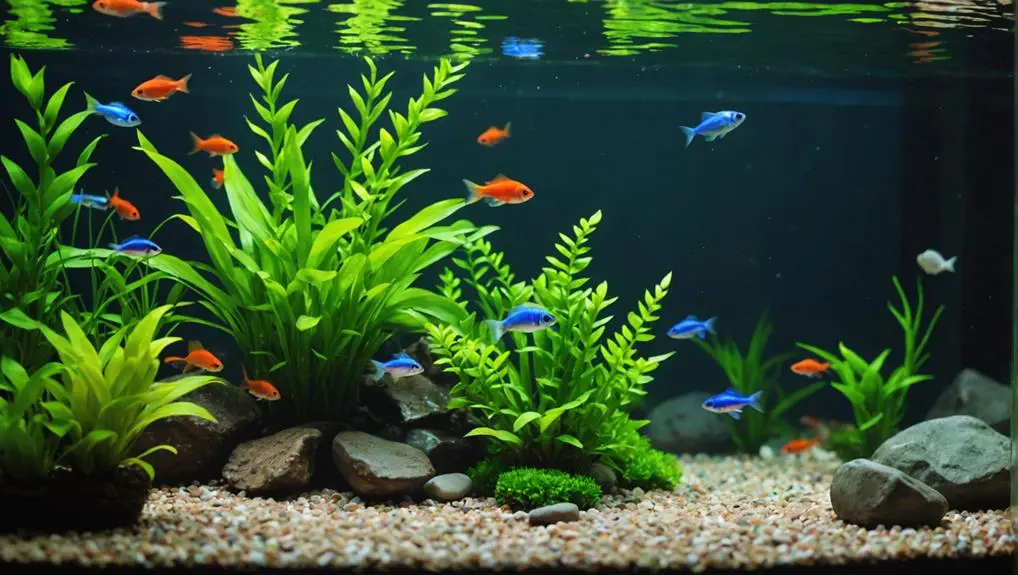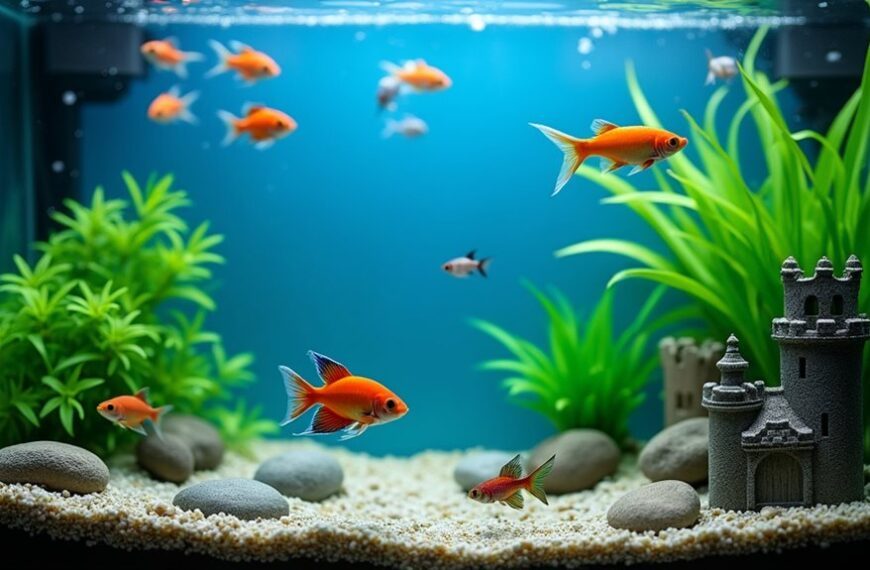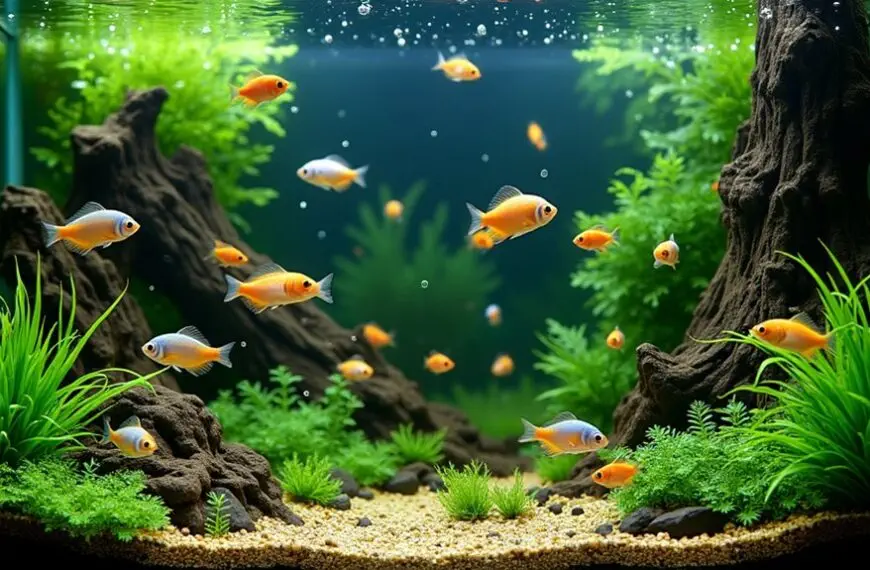Choosing the right fish for small aquariums can make a huge difference in creating a lively underwater world. Small fish like Neon Tetras, Pygmy Corydoras, or Chili Rasboras are perfect for tanks of 5-10 gallons because they thrive in cozy spaces and contribute vibrant color without overloading your tank. Plus, they're generally peaceful, making them great for community setups. With these tiny treasures, you'll enjoy easier maintenance and stable water conditions. Who doesn't love a tank that's both beautiful and hassle-free? Stick around, and you'll discover even more tips for setting up your little aquatic paradise!
Contents
Benefits of Small Aquariums
Small aquariums offer several advantages that make them an appealing choice for both novice and experienced fishkeepers. If you're just starting out, small tanks are a great way to dip your toes into keeping fish. They require less financial investment and are easier to maintain, meaning you can focus more on enjoying your aquatic friends.
Plus, with quicker water changes, you'll notice improved water quality, which is crucial for your fish's health. Proper tank size is essential, as smaller tanks help maintain stable water temperatures and quality, ensuring a healthier environment for your fish ideal tank size for nano fish.
One of the coolest things about small aquariums is the chance for creative aquascaping. You can design beautiful, intricate environments in a compact space, making your community tank not just a home for fish but a stunning piece of decor.
Additionally, keeping incompatible species separate in small tanks can help reduce aggression, leading to healthier fish communities.
Even if you're in a cozy apartment or a small room, these mini aquatic worlds fit perfectly into limited living spaces. So, whether you're dreaming of colorful guppies or tiny tetras, you can create a peaceful underwater retreat that brings joy to your life and a splash of serenity to your surroundings.
Why not dive into the world of small aquariums?
Ideal Fish for Tiny Tanks
When it comes to stocking your tiny aquarium, choosing the right fish is key to creating a thriving aquatic environment.
You'll want to focus on small fish that fit well in your tank size, ideally 5-10 gallons. Maintaining optimal water quality is crucial for the health of your fish; for instance, regular maintenance helps prevent ammonia spikes and supports a balanced ecosystem.
Consider vibrant Neon Tetras—they thrive in schools of 6-8 and add a splash of color to your tank.
For a peaceful community, Nano Fish like Pygmy Corydoras are perfect, usually reaching only 1-2 inches. They get along beautifully with others, making them ideal companions in community tanks.
Another fabulous option is the Celestial Pearl Danio, which grows to about 1 inch and also loves to school. Keeping at least six of them ensures they're social and happy.
Don't forget the hardy Chili Rasbora! These small aquarium fish are only about 0.8 inches long but require a school of at least ten to truly shine.
And if you're feeling adventurous, consider Betta fish, which can live solo in small tanks; just remember to keep an eye on their temperament.
With these choices, you're on your way to creating a delightful aquatic home!
Top Nano Fish Species Selection
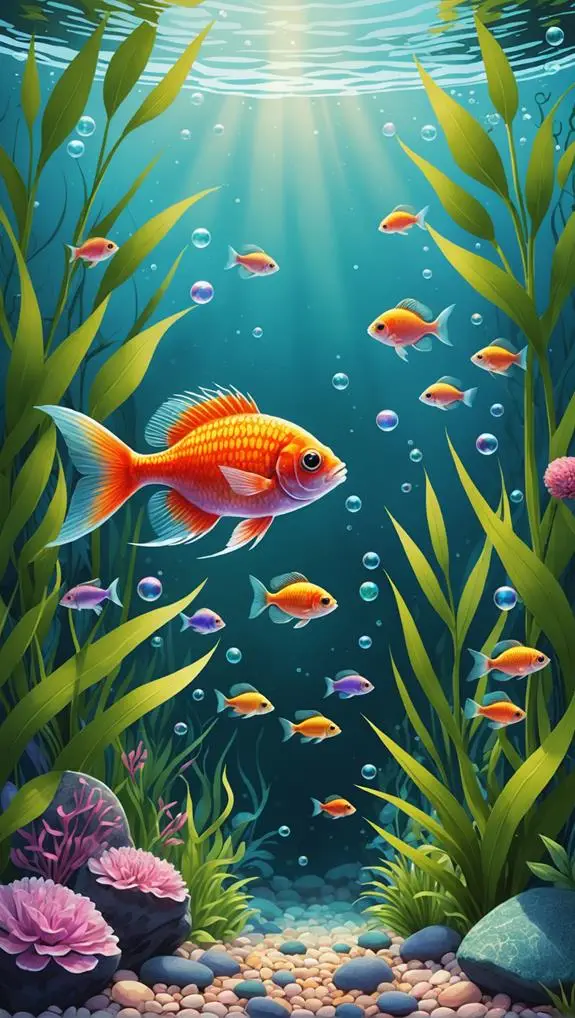
Choosing the right nano fish species can truly elevate your small aquarium experience. If you're looking to create a lively community, consider the Celestial Pearl Danio. This tiny fish, only about an inch long, thrives best in groups of at least six. Their colorful appearance and peaceful nature make them a stunning addition to any small tank.
Additionally, maintaining a balanced ecosystem is essential for their health, as live plants can provide oxygen and improve water quality. Regular water testing ensures a stable environment.
Another fantastic option is the Chili Rasbora, which grows just under an inch. To see their vibrant colors shine, keep them in schools of ten.
For the bottom of your tank, the Pygmy Corydoras is perfect. These little helpers maintain substrate cleanliness while also needing a group of six to feel at home.
Don't overlook the Green Neon Tetra; this eye-catching species adds dynamic movement to your setup. They prefer to swim in schools of 6-8 and can reach about 1.25 inches.
Lastly, the Kuhli Loach, a delightful snakelike fish, can be a great addition. Growing up to 4 inches, they're tolerant of various water conditions and bring unique behavior to your small aquariums.
Habitat Requirements for Small Fish
When you're setting up a cozy home for your small fish, tank size and water quality are key players in their happiness. A tank between 5 to 10 gallons usually gives them enough room to swim around without feeling cramped, and keeping an eye on the water temperature and pH levels can be like playing Goldilocks—finding just the right fit for each species.
Regular testing is crucial for ensuring that ammonia and nitrite levels remain at 0 ppm, which is vital for preventing stress and health issues in your fish optimal ammonia levels.
Regular water changes are like a spa day for your fish, helping to keep their environment clean and stress-free, so they can swim around with their little fishy smiles!
Tank Size Considerations
How do you ensure your small aquarium remains a comfortable home for its inhabitants? First off, choosing the right tank size is crucial. For small aquariums under 10 gallons, you want to select fish that only grow to a maximum size of 2-3 inches. Peaceful, social nano fish like Endler livebearers and Neon Tetras are perfect; they thrive in groups, so aim for at least 6-10 of them.
Next, consider their habitat needs. Small fish like Pygmy Corydoras and Chili Rasboras love well-planted tanks. Plants not only provide hiding spots but also help reduce stress levels—after all, nobody wants a jittery fish!
Keeping an eye on water parameters is essential too. Most small fish prefer slightly acidic to neutral pH levels, typically between 6.5 and 7.5.
And don't forget about regular water changes! In small tanks, waste can build up quickly, so aim for changing about 20-30% of the water each week.
With these steps, you'll create a cozy and thriving environment that your fish will love. Plus, a happy fish tank makes for a happy fish owner!
Water Quality Parameters
Maintaining optimal water quality is essential for the health and well-being of small fish in your aquarium. These little swimmers thrive in a temperature range of 72-78°F and need stable pH levels, ideally between 6.5 and 7.5. Many species, like Tetras and Rasboras, prefer soft, slightly acidic water.
Regular water changes of 10-20% each week will help keep the water fresh and minimize the buildup of harmful substances like ammonia and nitrite.
Filtration efficiency is also crucial. Using sponge filters or gentle hang-on-back filters ensures adequate oxygenation without creating strong currents that might stress your timid fish.
Plus, consider adding live plants to your small aquarium. They not only beautify the tank but also absorb excess nutrients, helping improve water quality.
Creating a balanced environment with soft, acidic water and regular maintenance will keep your small fish happy and healthy.
Feeding Practices for Small Aquariums
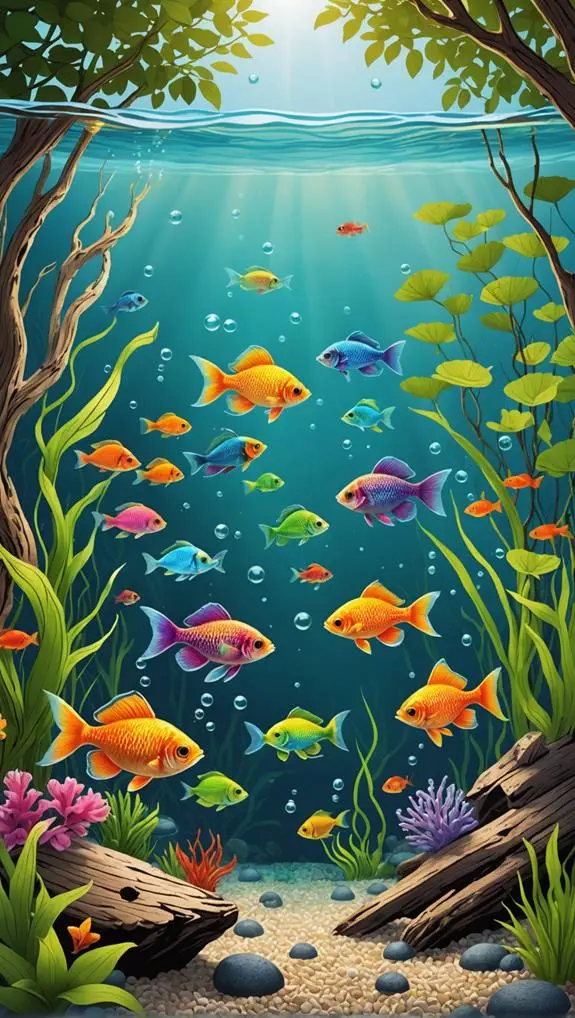
When it comes to feeding your fish, understanding their nutritional needs is key to keeping them happy and healthy.
You'll want to adjust how often you feed based on the size and species of your fish, so don't be surprised if your tiny buddies need snacks more frequently than the bigger ones.
Plus, treating them to some tasty extras like bloodworms or brine shrimp can really brighten their day—just make sure not to overdo it, or you'll end up with a mini fish buffet and a messy tank!
Nutritional Requirements of Species
To ensure your small aquarium fish thrive, you need to provide a diet that meets their specific nutritional requirements. Start with high-quality flakes or pellets designed for small fish; these should be the cornerstone of their diet. Small tetras, for instance, love these nutritious options, and they help support their vibrant colors and overall health.
Don't forget to add a variety in diet! Treat your fish with occasional snacks like brine shrimp or bloodworms. Not only do these make for happy fish, but they also enhance their health.
If you've got bottom dwellers like Corydoras or loaches, consider sinking tablets or wafers. They'll appreciate having a meal right at their level, ensuring they don't miss out on important nutrients.
Keep an eye on your fish's dietary preferences, too. Some may prefer floating food, while others are more inclined to munch on sinking options.
Adjusting feeding frequency is key, as smaller fish often do well with 1-2 feedings a day. But remember, even fish can overeat! So, it's all about striking that perfect balance to meet their nutritional needs while keeping your community tank lively and healthy.
Feeding Frequency Guidelines
Finding the right feeding frequency for your small aquarium fish is crucial for their health and happiness. Generally, feeding them once or twice daily is best. Just give them small portions that they can gobble up within a few minutes. This helps avoid overfeeding, which can mess with your water quality.
High-quality flakes or sinking pellets designed for small fish should be the mainstay of their diet. Occasionally treat them with live food like brine shrimp or bloodworms to keep things exciting!
If you have bottom-dwelling species, like Corydoras, you'll want to use sinking pellets to ensure they get their fair share without competing at the surface.
Remember, different fish have different needs. For example, livebearers might thrive on a slightly higher feeding frequency, while more sensitive species may prefer less.
Don't forget to keep an eye on your fish during feeding times. Monitoring fish behavior can tell you a lot about their health. If they're losing interest in food, it might be time to investigate further.
After all, happy fish make for a happy aquarium!
Treats and Supplements Options
Keeping your fish healthy and vibrant goes beyond regular feeding; treats and supplements can play a significant role in their overall well-being.
Start with high-quality pellets and flakes as the staple diet for your small aquarium fish. They're specially formulated to ensure your little swimmers grow strong and happy.
To spice things up, consider adding small amounts of frozen or freeze-dried treats like bloodworms or brine shrimp. These goodies can enhance colors and promote well-being, especially for species like Betta and Gouramis.
For your bottom-dwelling fish, such as Corydoras and Pygmy Loaches, sinking wafers are essential. They prevent those little guys from competing with surface feeders.
Community Tank Compatibility
Creating a harmonious community tank in a small aquarium can be a rewarding experience, but it requires careful selection of fish species.
You'll want to choose small fish species like Endlers Livebearers and Neon Tetras, as they're peaceful and usually get along well. Keeping a school of at least six compatible species, like Pygmy Corydoras, helps enhance the community dynamics and keeps the tank stable.
It's crucial to avoid larger fish, as they might show aggression towards your smaller tank mates, causing stress or harm. Look for tank mates that share similar water parameter preferences, so everyone feels comfy and happy in their aquatic home.
When you introduce new fish, pay close attention to their behavior. Some small species can be surprisingly territorial, and you don't want any unexpected squabbles in your peaceful oasis.
It's all about ensuring introductions compatibility. By carefully selecting your fish and observing their interactions, you can create a vibrant community tank that thrives together—like a little underwater family.
After all, who wouldn't want a lively and serene space filled with colorful, happy fish?
Health Management Strategies
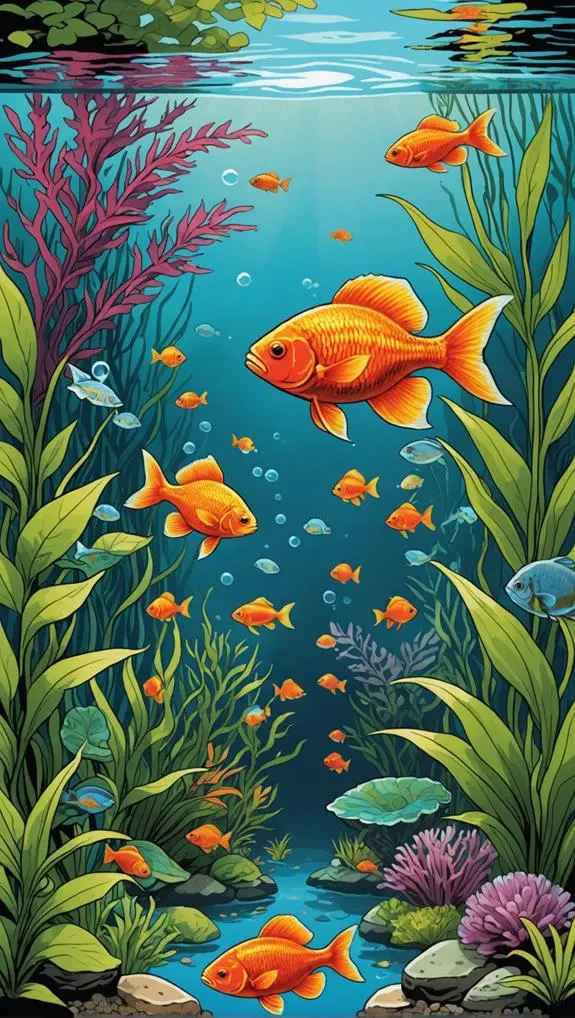
Maintaining a healthy environment is crucial for the well-being of your small aquarium fish. To keep your community thriving, regular water testing is essential. You'll want to check ammonia, nitrite, nitrate, pH, and temperature to ensure your tropical fish, like guppies and tetras, are living their best lives.
Don't forget about partial water changes! Changing 25-50% of the water weekly helps maintain water quality and prevents harmful waste buildup.
Quarantining new fish for at least two weeks is another smart strategy. This practice helps stop the spread of diseases and parasites, protecting your sensitive established tank.
Plus, keep an eye on your fish behavior. Changes in how they eat can signal stress or health issues, so pay attention!
Staying informed about common health issues—like ich or fin rot—will also serve you well. The sooner you spot a problem, the better your fish's chances for a long, happy life.
Common Mistakes to Avoid
When it comes to small aquariums, one of the biggest pitfalls is overcrowding, which can quickly lead to poor water quality and stressed fish. You might think cramming in more fish means more fun, but trust me, it's a recipe for disaster.
To help you avoid common mistakes, here are some key points to keep in mind:
- Stick to the inch-per-gallon rule: Ensure your total fish length doesn't exceed one inch per gallon. This helps maintain water quality in small tanks.
- Monitor water parameters: Regularly check pH and ammonia levels. Small volumes of water can change rapidly, impacting your fish's health.
- Provide hiding spaces: Inadequate hiding spots can cause stress and aggression, especially in territorial fish like bettas. Give them places to retreat!
- Research species compatibility: Ignoring which fish get along is a big no-no. Always check that your chosen species can coexist peacefully in your small aquarium.
Frequently Asked Questions
Which Fish Is Best for a Small Aquarium?
For a small aquarium, consider colorful small fish like guppies and neon tetras, alongside peaceful fish types like pygmy corydoras. These active small fish and schooling fish varieties create a vibrant, harmonious community tank.
What Factors Must Be Considered When Selecting Fish for an Aquarium?
When selecting fish for your aquarium, consider tank size, water temperature, and fish compatibility. Also, think about feeding habits, behavior patterns, aquascaping options, schooling fish, disease resistance, and lifespan to ensure a thriving environment.
How to Choose Fish for an Aquarium?
Choosing fish for your aquarium's like crafting a harmonious symphony. Consider compatibility, water parameters, growth potential, and behavioral traits. Focus on schooling species and their maintenance needs to ensure a thriving, peaceful aquatic community.
What Is the Best Beginner Fish in a Small Tank?
If you're starting a small tank, consider guppy types, neon tetras, or endlers livebearers for vibrant colors and compatibility. Cherry shrimp, dwarf puffers, and micro rasboras also thrive, enhancing your aquarium's beauty and harmony.
Final Thoughts
In the world of small aquariums, choosing the right fish makes all the difference. Did you know that nano fish can thrive in tanks as small as 5 gallons? That's right! These tiny swimmers bring vibrant color and life to your space without needing a huge setup. By understanding their needs and keeping a close eye on their health, you can create a thriving underwater community. So, dive in and enjoy the wonderful world of small aquarium fish!

